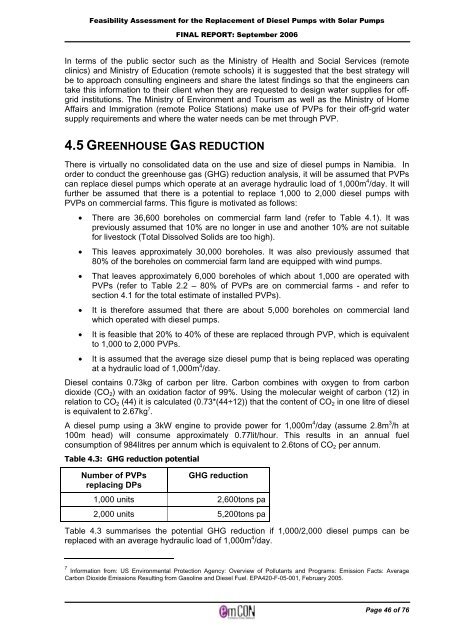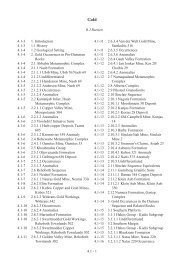Solar PV water pumping study - FINAL REPORT ... - UNDP, Namibia
Solar PV water pumping study - FINAL REPORT ... - UNDP, Namibia
Solar PV water pumping study - FINAL REPORT ... - UNDP, Namibia
Create successful ePaper yourself
Turn your PDF publications into a flip-book with our unique Google optimized e-Paper software.
Feasibility Assessment for the Replacement of Diesel Pumps with <strong>Solar</strong> Pumps<br />
<strong>FINAL</strong> <strong>REPORT</strong>: September 2006<br />
In terms of the public sector such as the Ministry of Health and Social Services (remote<br />
clinics) and Ministry of Education (remote schools) it is suggested that the best strategy will<br />
be to approach consulting engineers and share the latest findings so that the engineers can<br />
take this information to their client when they are requested to design <strong>water</strong> supplies for offgrid<br />
institutions. The Ministry of Environment and Tourism as well as the Ministry of Home<br />
Affairs and Immigration (remote Police Stations) make use of <strong>PV</strong>Ps for their off-grid <strong>water</strong><br />
supply requirements and where the <strong>water</strong> needs can be met through <strong>PV</strong>P.<br />
4.5 GREENHOUSE GAS REDUCTION<br />
There is virtually no consolidated data on the use and size of diesel pumps in <strong>Namibia</strong>. In<br />
order to conduct the greenhouse gas (GHG) reduction analysis, it will be assumed that <strong>PV</strong>Ps<br />
can replace diesel pumps which operate at an average hydraulic load of 1,000m 4 /day. It will<br />
further be assumed that there is a potential to replace 1,000 to 2,000 diesel pumps with<br />
<strong>PV</strong>Ps on commercial farms. This figure is motivated as follows:<br />
• There are 36,600 boreholes on commercial farm land (refer to Table 4.1). It was<br />
previously assumed that 10% are no longer in use and another 10% are not suitable<br />
for livestock (Total Dissolved Solids are too high).<br />
• This leaves approximately 30,000 boreholes. It was also previously assumed that<br />
80% of the boreholes on commercial farm land are equipped with wind pumps.<br />
• That leaves approximately 6,000 boreholes of which about 1,000 are operated with<br />
<strong>PV</strong>Ps (refer to Table 2.2 – 80% of <strong>PV</strong>Ps are on commercial farms - and refer to<br />
section 4.1 for the total estimate of installed <strong>PV</strong>Ps).<br />
• It is therefore assumed that there are about 5,000 boreholes on commercial land<br />
which operated with diesel pumps.<br />
• It is feasible that 20% to 40% of these are replaced through <strong>PV</strong>P, which is equivalent<br />
to 1,000 to 2,000 <strong>PV</strong>Ps.<br />
• It is assumed that the average size diesel pump that is being replaced was operating<br />
at a hydraulic load of 1,000m 4 /day.<br />
Diesel contains 0.73kg of carbon per litre. Carbon combines with oxygen to from carbon<br />
dioxide (CO2) with an oxidation factor of 99%. Using the molecular weight of carbon (12) in<br />
relation to CO2 (44) it is calculated (0.73*(44÷12)) that the content of CO2 in one litre of diesel<br />
is equivalent to 2.67kg 7 .<br />
A diesel pump using a 3kW engine to provide power for 1,000m 4 /day (assume 2.8m 3 /h at<br />
100m head) will consume approximately 0.77lit/hour. This results in an annual fuel<br />
consumption of 984litres per annum which is equivalent to 2.6tons of CO2 per annum.<br />
Table 4.3: GHG reduction potential<br />
Number of <strong>PV</strong>Ps<br />
replacing DPs<br />
GHG reduction<br />
1,000 units 2,600tons pa<br />
2,000 units 5,200tons pa<br />
Table 4.3 summarises the potential GHG reduction if 1,000/2,000 diesel pumps can be<br />
replaced with an average hydraulic load of 1,000m 4 /day.<br />
7 Information from: US Environmental Protection Agency: Overview of Pollutants and Programs: Emission Facts: Average<br />
Carbon Dioxide Emissions Resulting from Gasoline and Diesel Fuel. EPA420-F-05-001, February 2005.<br />
Page 46 of 76




